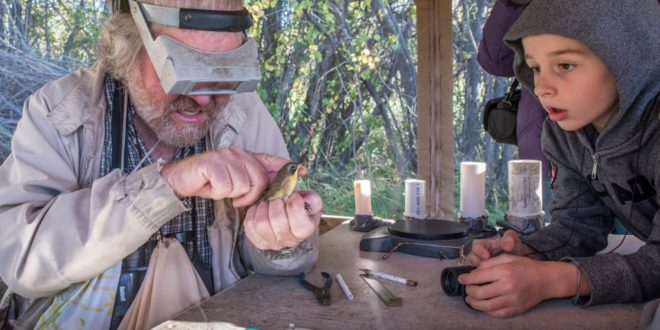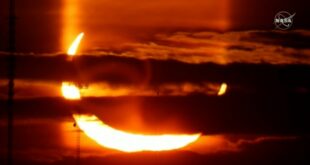Doug Brown pulls a tiny common yellowthroat from a sack and examines the bird as a group of children and adults looks on.
The young male juvenile has just been caught in one of the mist nets at the Vaseux Lake Bird Observatory (VLBO), where Brown, the bird bander in charge, records information about birds making their southbound migration.
Sunday was the second of two family days at the bird banding station located in the wetlands just north of Vaseux Lake, located north of Oliver and south of Okanagan Falls.
Dozens of youngsters and adults came by that morning for a tour and to see the banding in process.
Brown, who lives in Osoyoos, attaches a band to the little bird’s legs and weighs it. When all its information has been recorded, he gently drops it into a wide plastic pipe where it makes its way to freedom outside the banding tent.
“We band them, we weigh and measure them and age and sex them and then we send them on their way,” he says.
The program is run by the Okanagan Similkameen Conservation Alliance (OSCA) and it receives federal funding through the Canadian Wildlife Service, which owns the land. It runs from Aug. 1 to Oct. 15.
The banding station is the only one of its kind in the B.C. Southern Interior, although there are eight other migration monitoring stations elsewhere in the province.
It’s been in operation for 15 years and Brown has been running the station for the past 10 years.
The Vaseux Lake area was chosen because it’s where the Okanagan Valley starts narrowing before it reaches its narrowest point, at McIntyre Bluff.
The theory was that it would concentrate the birds, but Brown said bird watchers know the birds actually migrate along the lower slopes of the mountains rather than along the valley bottom. Still, many songbirds do land amidst the riparian vegetation of the valley bottom.
Besides, with a set of data now collected over the past 15 years, it wouldn’t make sense to change the baseline.
In addition to the family days on Sept. 19 and 27, the bird observatory has recently been able to show its activities off to school children during the week.
“We were able to develop a school program that complements the B.C. Ministry of Education’s science curriculum,” said Janet Wilson, OSCA chair, adding that students from 12 schools from Osoyoos to Summerland are attending the program in September and October.
Species commonly sampled at the VLBO are orange-crowned warbler, grey catbird, song sparrow, willow flycatcher, Audubon’s warbler and common yellowthroat.
The data collected goes to the Canadian Wildlife Service and also to Bird Studies Canada, Brown said.
“They try to keep track of endangered species and species that are of concern,” said Brown. “They do a lot of work across Canada.”
Why should people care about bird populations?
“Because they are a good indication of the health of the environment,” Brown said.
All species are interconnected, he adds, so the loss of one species could tip the balance and cause unforeseen and even catastrophic consequences.
By recording the ages and sexes of the birds, it helps to track how successful their breeding season was, he said.
The station has 14 mist nets suspended between poles that are used to catch the birds. These are checked for birds at least every half hour.
Separate from the bird banding, personnel also do observations of other bird activity in the area. Most of the work is done each morning for about six hours, but from mid-September to mid-October, they also do nighttime catching and banding of saw-whet owls.
Although the family days were specially organized events, Brown said the station is open to visitors at other times.
“Unless I’m absolutely inundated with birds, I make sure that I take the time and try to show them everything so that they see exactly what we’re doing,” he said.
The busiest time for bird activity is usually from 8 to 10 a.m., he said.
You can read more of the news on source
 Travelsmart
Travelsmart



